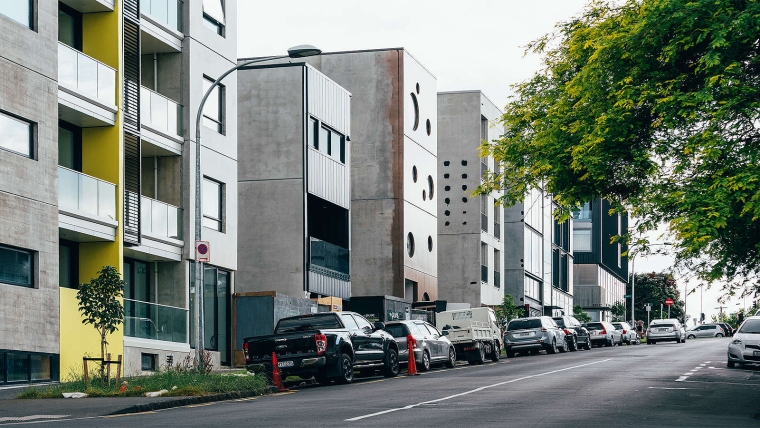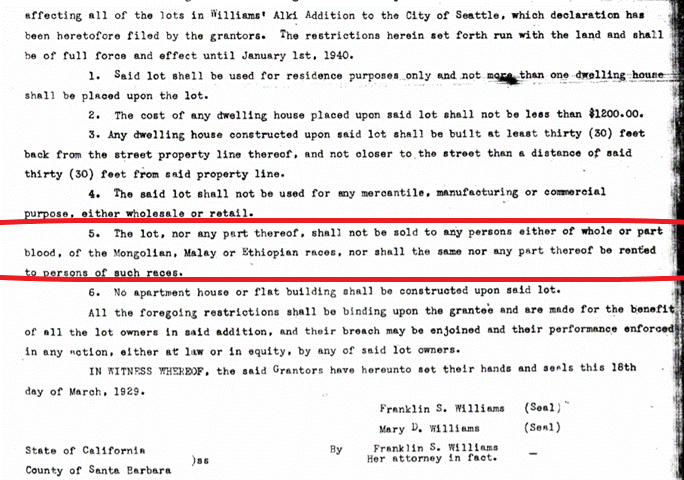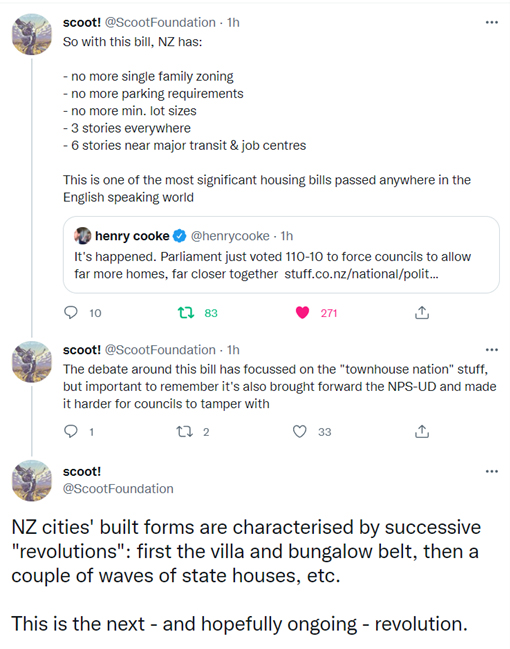
By Brendon Harre*
“The American real-estate industry believed segregation to be a moral principle. As late as 1950, the National Association of Real Estate Boards’ code of ethics warned that “a Realtor should never be instrumental in introducing into a neighborhood … any race or nationality, or any individuals whose presence will clearly be detrimental to property values.”

Single house zoning charts its history back to the early 1900’s in the United States when private covenants and local government zoning had the purpose of excluding people by race and income. Source from Racial Restrictive Covenants compiled by The Seattle Civil Rights and Labor History Project.
Going into Christmas a surprise gift to the nation has been legislation that enables a more permissive built environment. Even more surprising this legislation was a bipartisan housing accord between Labour and National. This consensus approach means permissive urban environments will be enduring— it prevents policy reversals like the US has experienced with housing.
The most important effect of the housing legislation will be the ending of single house zoning over New Zealand’s largest urban areas. The Bill’s legislative architect was David Parker the Minister of the Environment. For National the bipartisan accord was lead by Deputy Leader Nicola Willis. Their Final Reading speeches from the Bill can be viewed here and here. National’s Erica Stanford also gave a speech that was well grounded in the difficulties that the housing crisis presents.

Most of the above rules will be implemented by local government by August 2022. Source
From first being publicly announced to the legislation being made law has taken less than two months. Going forward building three-stories and three dwellings without consent will be a minimum right in New Zealand’s largest and fastest growing cities.
For Judith Collins this announcement did not save her job as the leader of the opposition. But for my part at least, I will remember she had the best response, when asked what reduced regulation means — will a community lose its character? Judith responded with “our communities lose their character when people can’t afford to own their own home.”
Segregating cities into different zones has always been a bad idea. Other than excluding a few nuisances — the noisy factory, the smelly abattoir — the idea has little merit. Regulation that artificially forces down density is as bad as those places that have artificially high density.

Zoning is bad for the environment because it unnecessarily separates activities and people which increases the pollution and congestion cost of city-travel.
Zoning is bad for productivity because it makes it harder for businesses, workers and customers to access each other.
And zoning is bad for inequality because it prevents poorer people from pooling their resources in the form of multi-unit dwellings so they can live in accessible urban locations that have better opportunities.
Zoning is like a monopoly — for society as a whole it is bad, but for the individuals that benefit it is good — meaning there are powerful interests for creating and maintaining them.

The Coalition for More Homes (CFMH) proposal for an alternative medium density residential standard (MDRS).
I could complain about some aspects of the medium density residential standards that the Bill enables and the way the government has talked about housing more generally.
- The government could have been more strategic about improving the built environment by encouraging better urban forms rather than the increased permissiveness being focused on sausage flat type developments.
- Mixed-use commercial activity could have been made ‘as of right’ by legislation too.
- The Bill gives a right to build that favours fewer larger dwellings (up to three). The same built envelope cannot ‘by right’ be divided into a greater number of smaller dwellings. A right to build low-rise apartments would further help less well-off households access city-locations that have better opportunities.
- The Bill could have applied to more urban areas — not just the Tier-1 cities — Auckland, Hamilton, Tauranga, Wellington and Christchurch.
- The prime minister could talk more about the right to build for those without access to decent housing, rather than voicing concern about property values for those with housing. This type of talk is too close to the pre-1950s American Realtor speak for my liking. But she does seem to be walking back some of her statements about sustainable house price growth — more of this would be welcomed.
These details and without a doubt many more bring into question implementation and competence — a very contentious issue. Yet over time details can be improved.
The big picture importance of the latest housing legislation is at the highest political level there is consensus for the planning system becoming more permissive and less segregating. Exclusion in the DNA of our built-environment is now considered to be morally wrong — permissiveness is being hardwired into the system. This is a gift worth celebrating. I gratefully receive it and hope for more such gifts in the future.
This is a repost of an article here. It is here with permission.
21 Comments
A good Christmas gift that explains America’s history of using its planning and financial systems for racist segregating purposes is The Color of Law — A Forgotten History of How Our Government Segregated America by Richard Rothstein.
Sure Brendon, but is it relevant here in nz for kiwi developers. It sounds like something politicians should wrap their heads around
Thanx for the above article
Thanks for the kind words. I think the history is important for NZ too - especially as race is an element in our poor housing statistics.
"...race is an element in our poor housing statistics"
Correlation is not causation.
It's nothing to do with race - but a lot to do with wilful blindness.
"Zoning is bad for the environment because it unnecessarily separates activities and people which increases the pollution and congestion cost of city-travel."
Nonsense. We zoned to get away from cottages clustered around dark satanic mills. We zoned for amenity. What we didn't zone for, was unsustainable overpopulation, nor for the inability of cities to be kept going in a powerdown world. Which is happening, if anyone bothered to read the signs. Sunlight on a house, is the next thing to gold, make that 'worth more than gold'. How can yyou have passive solar with a 3-storey house next door, and no allowance made for North? It's crass ignorance. The fact that it's apolitically agreed, is even more worrying. Means the ignorance is endemic.
Not that much will change. We're out of time, now, globally. Supply issues are a permanent feature and will increase. Can't be any other way on a finite, overpopulated planet. As a species, we were too arrogant. As this piece demonstrates.
Not too worried about the urban "environment", we've been talking about urban planning for years but it went nowhere and house prices have exploded. If we're going to retain our love of dumpy cities they should at least be cheap.
One thing I would point out though is that we will never have high density cities because the land area already zoned low density residential is already huge and population growth isn't sufficient to back fill. Unless we eventually get to the point Detroit has and can make strategic use of bulldozers.
This legislation might help prevent our absurd house prices getting much more absurd. What it certainly won't do is realise housing that is significantly more affordable. So, really, it's yet another band aid that makes it look like government is doing something.
But thank God the government listened, even just a little, for a change and tightened the absurd shading rules they originally proposed.
I actually thought originally that this legislation might pump up prices in the short term by creating a developer frenzy for good sections. But I don't have that fear anymore given access to finance is getting harder as is the cost of finance.
PS this legislation might have been effective if enacted 5 or 10 years ago.
Apart from the short term boost during construction, in most single house zones there is no significant employment opportunities. So expect more commuting. Cars. Or unemployment from intensification.
I have heard the re-zoning of quality single house zoning areas being called vandalism. To demolish lovely old villas, bungalows, art and craft, industrial modernistic houses is absolutely criminal in my view.
"no significant employment opportunities" - most of the suburbs within walking distance to Auckland city are zoned single house or heritage or similar.
Not all lovely old villas will be demolished, just like not all model T Fords have been demolished. If people like them, a lot will stay.
Quite. This is part of the lunacy of the status quo. The inner ring of suburbs which are within walking distance of the Auckland CBD have been protected, while densification takes place in distant suburbs with poor public transport. Absolute madness.
I have the opposite view (this is not a troll post). I grew up in a villa. I wouldn't wish the coldness and heat-wasting 14 foot studs on anyone. Bulldoze all the rubbish things apart from a few museum pieces so our great grandchildren will be able to see how horrible houses used to be. While we're at it, abolish Heritage NZ and the heritage part of the Ministry of Culture and Heritage - our housing heritage is nothing to be proud of.
Of the three pictures of neighborhoods the "American Style Socialism: Forced Low Density" looks like the one I'd rather live in...by far.
I never understood that, looks pretty boring. Ever lived overseas?
You don't live much outside of the house. Those houses are nice and separate from their neighbours, like little castles. You have a bit of a buffer shielding you from other people and maintenance will be your own concern. You have parking inside your property for a couple of cars.
Good thing that permissive urban environments offer lots of choices to meet different preferences.
DP
Yup, just join up Auckland and Hamilton with single low density housing , that's the sort of room you'd need . Of course , you'd also need american style mega malls , with the Whangamarino swamp filled in for the parking lot.
So why only 6 stories high, why not 7, 8 etc.?
I still think the cost of land is going to undermine the effectiveness of this. At least with the 2020 decision you had to build near transit corridors with much improved density, but this significantly reduces that focus by allowing you to pepper intensity at a lower scale everywhere.
And that's good if your focus is just 'more everywhere' like it might for a government facing down a housing backlash in the face of exploding prices they promised to remedy in order to get elected, but land prices cost so much and our ability to constrain construction costs suggests we're still going to see cheaper, outlying land get the most intense development for a significant period of time. So while it's possible to now build more centrally, I'm not sure that at three levels it will actually make financial sense for people to do.
Land 'prices' (it's just debt-reflected demand) are due to go exponentially upward.
We are attempting to mitigate the use of underground-stored, historical acres (years of sunlit ones, which are the fossil fuels). We attempting that mitigation above ground - it can only be impactive. And we are degrading farmland, everywhere. To feed those in cities, too crammed together ALREADY, to survive what is coming). And asking it to feed ever-more. The need to build 'up', should always be a warning that we are becoming too compacted. And that we are overpopulated.
So there will never be 'enough' land from here on in, worsening increasingly. And post-collapse, the exodus (from cities) will be the biggest movement of humans in planetary history. At which point competition for food-producing land will be the issue.
Simplistic and very incomplete "history" accounted for in this article, planning history course at planning school was much more UK (eg new towns) and Europe based, not a history of US planning.
A one size fits all approach is not the way to go.
How about master planning areas, how about form based zoning?

We welcome your comments below. If you are not already registered, please register to comment
Remember we welcome robust, respectful and insightful debate. We don't welcome abusive or defamatory comments and will de-register those repeatedly making such comments. Our current comment policy is here.